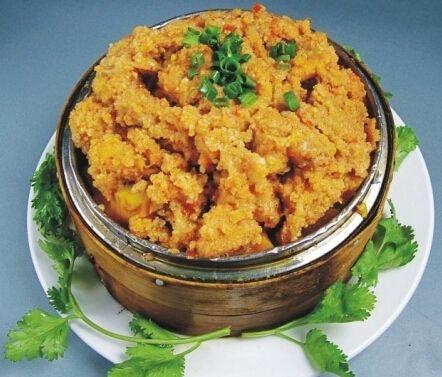"Original Cage Jade Hairpin"
Origin: Chongqing Category: hot dishes
Originally caged jade hairpin, originally named steamed pork ribs. In 1980, Chongqing chef Zeng Yaguang created the "Original Cage Jade Hairpin" on the basis of steamed pork ribs in order to add cultural meaning to the Sichuan rolls of "Chinese Famous Dishes". In ancient China, the flowers that were as white as jade, fragrant and delicate, containing buds like hairpins, and turning towards the twilight roll were called jade hairpin flowers; the white jade used by the palace people to scratch their heads was also called "jade hairpin" or "jade scratching head". The original caged jade hairpin is designed and created with reference to the shape and meaning of the jade hairpin flower and the jade scratching head. "Original cage" refers to the bamboo utensils of steamed vegetables, and "jade hairpin" is the shape of a jade hairpin after the pork ribs have been carefully trimmed, implying the meaning of Chen Panmiaohe. "Hairpin" is the jewelry inserted by ancient women in their hair buns, mostly made of metal and jade. After the pork loin ribs are steamed, they resemble hairpins, so they are named "jade hairpins". The original caged jade hairpin is made of pork ribs processed into a jade hairpin shape, and then mixed with a variety of spices and rice noodles, and steamed. The dish is shaped like a jade hairpin, the flesh is fat and soft, and the taste is strong and fragrant.

Original cage jade hairpin, hot dish, home-style type. Features: brownish red color, strong flavor and fresh flavor. Preparation: Steamed. The original cage jade hairpin was originally named steamed pork ribs, because the ribs were cut into sections and shaped like the jade hairpins used for decoration on women's heads in the past.
"Hechuan Meat Slices"
Hechuan meat slices, hot vegetables, lychee flavor type. Features: color like tea yellow, sweet and sour, fragrant, tender and delicious. Preparation: Fry and simmer. Hechuan meat slices are local dishes of Hechuan in Chongqing, and the original recipe was different from today. The recorded technical specifications are the usual law of today's restaurants.
Hechuan meat slices come from three versions:
When it comes to Hechuan, the first thing that comes to mind is probably Hechuan peach slices, and you don't know much about Hechuan meat slices. But ordinary pork slices can also make culture. In the fourth batch of Chongqing's intangible cultural heritage list, Hechuan meat slices traditional production techniques are on the list. Like Chongqing hot pot, Hechuan meat slices also originated from the water pier, which has a history of hundreds of years:
One day, after the restaurant left work, the chef will sell the leftover meat slices and scraps, wrap them with eggs and starch, fry them in oil until they are golden brown on both sides, and then add a variety of accessories and spices to cook and fry them for themselves to cook. I didn't expect it to be very delicious and delicious, and since then he has continued to make such Hechuan meat slices, which gradually become a flavor dish.
Second, on the occasion of the Southern Song Dynasty's resistance to Mongolia, Wang Jian of Zhizhou came to a tavern at the gate of Hejiang (Hechuan ancient called Hejiang) to eat. The little apprentice who took care of the shop saw Lord Zhizhou coming, and in a panic, he put the bean flour, eggs, tangyuan noodles and meat into the oil pot, and when the meat slices were fried to brown, he panicked and brought them to the table. Who knew that after Lord Zhizhou tasted it, he actually said, "Wonderful! wonderful! What is the name of this dish? The little apprentice casually said"Hezhou meat slices."
During the Qing Dynasty, an official from the city of Sichuan Province came to Hechuan by boat and went ashore into a hotel on River Street. The famous "Yuan Cannon" master of the river street food industry was a chef, and when he saw that there were foreign officials coming to the restaurant to eat, he brought a piece of crispy meat he had just figured out to the table, and the eater pointed at Master Yuan and said, "Hechuan meat slices, a delicacy!" "The art of making Hechuan meat slices has been passed down ever since.